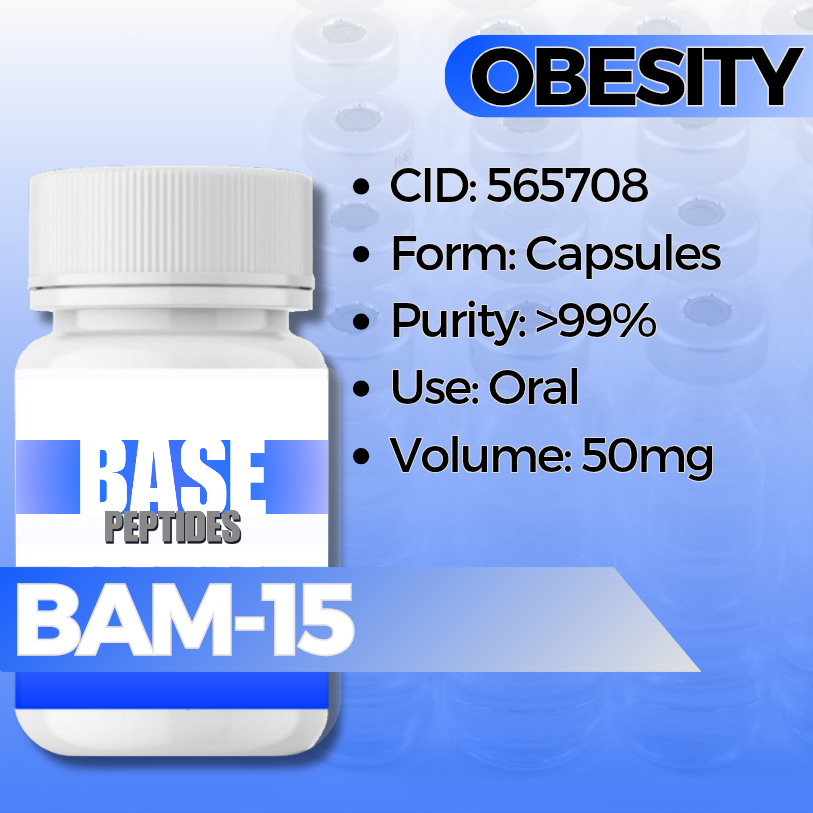BAM-15
BAM-15
Base Peptides are intended for licensed medical professionals and experienced researchers. Reconstitution required. Dosing and use instructions are not provided.
Regular price
$149.00
Regular price
Sale price
$149.00
Shipping calculated at checkout.
Quantity
Couldn't load pickup availability
BAM15 — Mitochondrial Protonophore Uncoupler (Metabolic Tool Compound)
BAM15 is an orally bioavailable, mitochondria-targeted protonophore uncoupler that increases nutrient oxidation and energy expenditure in preclinical models without altering food intake or core temperature in those studies.
Identifiers
- Chemical name: N5,N6-bis(2-fluorophenyl)-[1,2,5]oxadiazolo[3,4-b]pyrazine-5,6-diamine
- CAS No.: 210302-17-3
- PubChem CID: 565708
- Formula / MW: C16H10F2N6O • ~340.29 g·mol⁻¹
How It Works (Plain English)
- Acts as a mitochondrial protonophore, dissipating the proton gradient across the inner mitochondrial membrane (mild uncoupling).
- Uncoupling increases substrate oxidation and heat release in mitochondria, shifting whole-body metabolism toward higher energy expenditure in vivo models.
- Unlike older uncouplers, BAM15 is reported not to depolarize the plasma membrane in vascular cells at effective concentrations (mito-selective profile in those studies).
Why Researchers Use It
- To probe mechanisms of diet-induced obesity, insulin resistance, and hepatic steatosis via increased energy expenditure.
- To study insulin sensitivity using clamp techniques and lipidomics/metabolomics endpoints.
- To evaluate uncoupling in inflammation, sepsis, and oncology models.
Key Studies — What Was Tested, What Changed, Why It Matters
Diet-Induced Obesity & Insulin Resistance (mouse)
- What was tested: Oral BAM15 in high-fat-diet mice; body composition, food intake, indirect calorimetry, lipidomics, and euglycemic clamps.
- What changed: ↓ fat mass, ↑ nutrient oxidation, improved insulin sensitivity without changes in food intake or body temperature; no clinical chemistry toxicity signals reported in study.
- Why it matters: Positions mitochondrial uncoupling as a lever for energy expenditure with favorable metabolic effects.
Protection Against Obesity & Glycemic Control
- What was tested: BAM15-mediated uncoupling in DIO mice; glucose/lipid metabolism and adiposity outcomes.
- What changed: ↓ adiposity, improved glucose tolerance/insulin sensitivity, better lipid handling.
- Why it matters: Supports use in metabolic-syndrome research pipelines.
Broader Applications (reviews & translational angles)
- What’s reported: Review articles summarize possible roles in lowering hepatic glucose output, anti-inflammation, and organ aging biology through mito-metabolic reprogramming.
- Implication: Useful as a tool compound to dissect uncoupling across tissues and diseases (endocrine, immune, oncology).
Potential Research Applications
Metabolic Disease Models
- Diet-induced obesity, hepatic steatosis, insulin resistance
Mitochondrial Bioenergetics
- Respirometry (OCR), coupling/uncoupling parameters, ROS and membrane-potential assays
Inflammation & Oncology
- Sepsis and macrophage activation models; tumor metabolism and proliferative fitness
Synergistic / Comparator Agents
MOTS-c or SS-31
- Why pair: Contrast mitochondrial-uncoupling (BAM15) with mitochondrial-support peptides for combined bioenergetics panels.
GLP-1 / Cagrilintide (comparator)
- Why compare: Appetite-centric vs energy-expenditure-centric weight-loss mechanisms.
AMPK Activators (e.g., AICAR)
- Why compare: AMPK-first vs uncoupling-first metabolic remodeling.
Known Concerns (Context)
- Tool-compound status: Evidence is preclinical; human PK/safety not established.
- Thermogenesis/ROS: Uncoupling alters proton motive force and can affect ROS; dose-response and tissue specificity are critical.
- Selectivity vs plasma membrane: Reports of minimal plasma-membrane depolarization at effective doses, but verify in your system.
- General: For laboratory research use only; not for human consumption or therapeutic use.
Specifications & Handling
- Form: Small-molecule solid (lot-coded)
- Purity: Research-grade (HPLC/MS)
- Storage: Cool, dry; protect from light/moisture
- In solution: Soluble in DMSO; record solvent %, pH, and time-to-assay; minimize freeze–thaw
- Labeling: Tamper-evident; research-use-only; CAS and lot displayed
Regulatory & Use Notice
Sold for laboratory research use only. Not for human consumption, medical, or veterinary use. No human-use instructions are provided. Buyer is responsible for safe handling and regulatory compliance.
BAM15 Research Compound | Mitochondrial Uncoupler | Energy Expenditure, Obesity & Bioenergetics Studies


